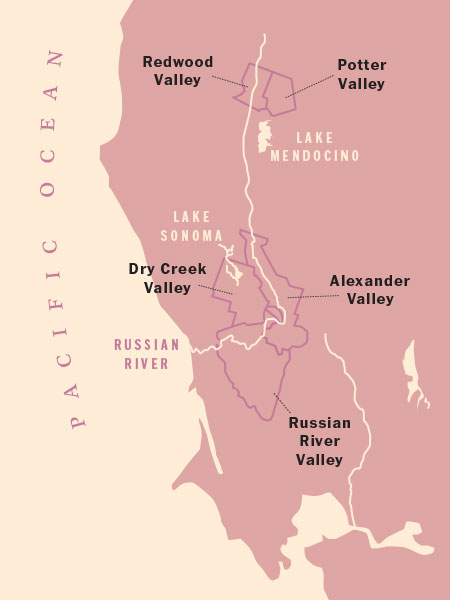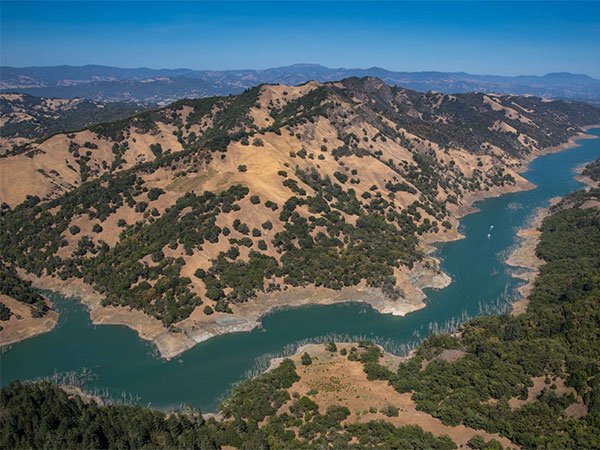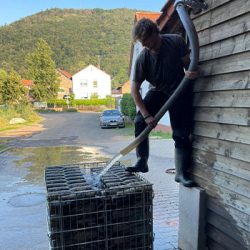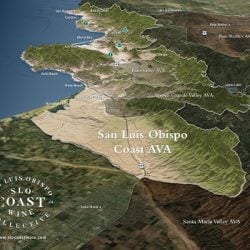In the face of a historic two-year drought, the California State Water Resources Control Board delivered a daunting one-two blow to farmers. On August 2, 2021, it ordered 1,500 water-rights holders to stop diversions from the upper Russian River, and the following day, the board issued a similar emergency directive for 5,700 rights holders in the Sacramento-San Joaquin Delta watershed.
The second announcement affected all of California’s Central Valley—not only the nation’s most productive agricultural area (containing three million acres of farmland), but the source of two-thirds of the state’s drinking water and 80 percent of its commercial salmon fisheries. The 110-mile-long Russian River, for its part, is arguably California’s most important winegrowing watercourse, sustaining hundreds of vineyards throughout Sonoma and Mendocino Counties.


Map by Lisa Lok
The Russian River’s upper watershed, reaching from Redwood and Potter Valleys in the north to Alexander Valley and Healdsburg in the south, is fed by Lake Mendocino, a manmade reservoir northeast of Ukiah. On August 1, the lake’s water level had fallen below 26,109 acre-feet (8.5 billion gallons), a threshold that triggers the halt of downstream diversions, so as to preserve water for “health and safety” purposes as well as federally protected fish populations. The “lower” Russian River extends from its confluence with Dry Creek, west of Windsor, to the Pacific Ocean near Jenner. Its primary storage source—Lake Sonoma, northwest of Healdsburg—is four times the size of Lake Mendocino. Both are managed (the latter with Russian River Flood Control) by the Sonoma County Water Agency, which distributes water throughout that county and parts of Marin.
Sonoma’s water customers are almost exclusively urban. Some of them sell water in turn to vineyardists, but during a drought, drinking water has higher priority than crop irrigation. In any case, based on flow calculations and hydrologic modeling, curtailment of more than 300 water rights in the lower Russian watershed were issued on August 10th. Everywhere, violators are subject to fines of $1,000 per day.
In the recent past, the Russian River has twice been subject to water-rights curtailments—during the droughts of 1976-77 and 2014-15. Never before, though, have “senior” rights—awarded before 1914, when permits began to be required—been suspended.


Photo by George Rose
“For this to happen is pretty unprecedented,” confirmed Janet Pauli, a Potter Valley winegrower who also chairs the Mendocino County Inland Water and Power Commission. “[Our water] runs the gamut from riparian rights to appropriative rights to the Potter Valley Irrigation District to a contract with Russian River Flood Control to treated wastewater from Ukiah. All of them except the wastewater have been curtailed in one way or another.”
Given that scenario, vine growers throughout the North Coast have had to alter their farming practices. “We’ve been cultivating since March, eliminating cover crops we normally would have mowed and left, in order to get rid of competition with the vines and seal moisture in the soil,” said Pauli. “If we can continue to have enough to drip on an extended schedule, I think we’ll get to veraison and far enough down the road to ripen the fruit.”
Reducing crop load is another likelihood. “The last thing you want is for crop to be stressed to the point where you can’t ripen the grapes,” said Pauli. “Then you lose everything.”
Many, if not most, vineyards have alternative sources of water, such as ponds or wells. But with an unusually hot summer following the drought, some of those have been going dry. “From here on out, the only water available for agriculture is from alternative sources—groundwater or a flood-control contract,” said Devon Jones, executive director of the Mendocino County Farm Bureau. “Those who don’t have [any] are most at risk.”
That cohort included Glenn McGourty, a Mendocino County supervisor whose district includes Lake Mendocino and Potter Valley. The former U.C. Davis Extension local farm advisor, McGourty grows marsanne, roussanne, viognier and arneis along the Russian River between Ukiah and Hopland.
Nevertheless, he said, “I’m finished. I don’t have a well, so I can’t irrigate. The good news is that we’re close to harvest, so hopefully the crop will make it without all the leaves falling off the plants. But it’s been a tough year. There’s some heat damage and shriveling, so the crop will be light, with lower yields, early ripening, high pH and low acidity.”
“Winemakers can fix those things,” McGourty expected. “Other than sunburn, the fruit is pretty clean. There’s just not a lot of it.”
W&S's James Beard Award—winning special correspondent David Darlington is the author of five books, among them An Ideal Wine and Angels' Visits: An Inquiry into the Mystery of Zinfandel (later retitled Zin).
This story appears in the print issue of October 2021.
Like what you read? Subscribe today.




















